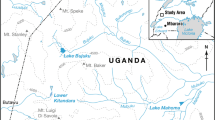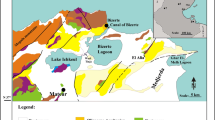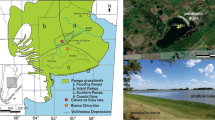Abstract
Holocene environmental and climatic changes are reconstructed using analyses of biological proxies in lake sediments from Vuolep Njakajaure, a lake located near the altitudinal treeline in northern Sweden (68°20′ N, 18°47′ E). We analysed biological proxy indicators from both aquatic and terrestrial ecosystems, including diatoms, pollen and chironomid head capsules, in order to reconstruct regional Holocene climate and the development of the lake and its catchment. During the early Holocene and after 2500 cal b.p., Fragilaria taxa dominated the diatom assemblages, whereas planktonic Cyclotella taxa prevailed during the major part of the Holocene (7800–2300 cal b.p.), indicating the importance of the pelagic habitat for diatom assemblage composition. The planktonic diatoms appeared at the same time as Alnus became established in the catchment, probably altering nutrient availability and catchment stability. The pollen record is dominated by mountain birch (Betula pubescens ssp. tortuosa) pollen throughout the Holocene, but high percentage abundances of Scots pine (Pinus sylvestris) pollen suggest the presence of a mixed pine-birch forest during the mid-Holocene (6800–2300 cal b.p.). Head capsules of Tanytarsini and Psectrocladius dominated the chironomid assemblage composition throughout the Holocene, in combination with Corynocera ambigua after 2300 cal b.p. A quantitative, diatom-based reconstruction of mean July air temperature indicated a relatively cold temperature during the early Holocene (9000–8000 cal b.p.) and after ca. 2300 cal b.p., whereas the mid-Holocene period is characterised by stable and warm temperatures. The overall patterns of Holocene climate and environmental conditions are similarly described by all biological proxy-indicators, suggesting relatively warm conditions during the mid-Holocene (ca. 7800–2300 cal b.p.), with a subsequent colder climate after 2300 cal b.p. However, the onset and magnitude of the inferred changes differ slightly among the proxies, illustrating different responses to lake development phases, land-uplift, and climate forcing (e.g., insolation patterns) during the Holocene in northern Sweden.








Similar content being viewed by others
References
Alexandersson H, Karlström C, Larsson-McCann S (1991) Temperature and precipitation in Sweden 1961–1990. Reference normals. Norrköping, SMHI report 81, 88 pp
Ammann B (2000). Biotic responses to rapid climatic changes: Introduction to a multidisciplinary study of the Younger Dryas and minor oscillations on a altitudinal transect in the Swiss Alps. Palaeogeogr Palaeoclimatol Palaeoecol 159:191–201
Barnekow L (1999a). Holocene tree-line dynamics and inferred climatic changes in the Abisko area, northern Sweden, based on macrofossil and pollen records. The Holocene 9:253–265
Barnekow L (1999b) Holocene vegetation dynamics and climate changes in the Torneträsk area, northern Sweden. Lundqua Thesis 43, Dept. of Quaternary Geology. Lund University, Lund, 30 pp
Barnekow L (2000). Holocene regional and local vegetation history and lake-level changes in the Torneträsk area, northern Sweden. J Paleolimnol 23:399–420
Barnekow L, Possnert G, Sandgren P (1998). AMS 14C chronologies of Holocene lake sediments in the Abisko area, northern Sweden —a comparison between dated bulk sediment and macrofossil samples. GFF 120:59–67
Battarbee RW (1986) Diatom analysis. In: Berglund BE (ed) Handbook of Holocene palaeoecology and palaeohydrology. John Wiley & Sons Ltd., Chichester, pp 527–570
Battarbee RW (2000) Palaeolimnological approaches to climate change, with special regard to the biological record. Quat Sci Rev 19:107–124
Beniston M (2005) Warm winter spells in the Swiss Alps: Strong heat waves in a cold season? A study focusing on climate observations at the Saentis high mountain site. Geophys Res Lett 32:L01812
Bennett KD (1996) Determination of the number of zones in a biostratigraphical sequence. New Phytol 132:155–170
Berger A, Loutre MF (1991) Insolation values for the climate of the last 10,000,000 years. Quat Sci Rev 10:297–317
Berglund BE, Ralska-Jasiewiczowa M (1986) Pollen analysis and pollen diagrams. In: Berglund BE (ed) Handbook of holocene palaeoecology and palaeohydrology. Wiley, Chichester, pp 455–484
Berglund BE, Barnekow L, Hammarlund D, Sandgren P, Snowball IF (1996) Holocene forest dynamics and climate changes in the Abisko area, northern Sweden – the Sonesson model of vegetation history reconsidered and confirmed. Ecol Bull 45:15–30
Bigler C, Hall RI (2002) Diatoms as indicators of climatic and limnological change in Swedish Lapland: a 100-lake calibration set and its validation for paleoecological reconstructions. J Paleolimnol 27:97–115
Bigler C, Hall RI (2003) Diatoms as quantitative indicators of July temperature: a validation attempt at century-scale with meteorological data from northern Sweden. Palaeogeogr Palaeoclimatol Palaeoecol 189:147–160
Bigler C, Hall RI, Renberg I (2000) A diatom-training-set for paleoclimatic inferences from lakes in northern Sweden. Verhandlungen der Internationalen Vereinigung für Theoretische und Angewandte Limnologie 27:1174–1182
Bigler C, Larocque I, Peglar SM, Birks HJB, Hall RI (2002) Quantitative multiproxy assessment of long-term patterns of Holocene environmental change from a small lake near Abisko, northern Sweden. The Holocene 12:481–496
Bigler C, Grahn E, Larocque I, Jeziorski A, Hall R (2003) Holocene environmental change at Lake Njulla (999 m asl), northern Sweden: a comparison with four small nearby lakes along an altitudinal gradient. J Paleolimnol 29:13–29
Birks HH, Battarbee RW, Birks HJB (2000) The development of the aquatic ecosystem at Kråkenes Lake, western Norway, during the late glacial and early Holocene – a synthesis. J Paleolimnol 23:91–114
Birks HJB (1968) The identification of Betula nana pollen. New Phytol 67:309–341
Birks HJB, Gordon AD (1985) The analysis of pollen stratigraphical data. Zonation. In: Birks HJB, Gordon AD (eds) Numerical methods in Quaternary pollen analysis. Academic Press, London, pp 47–90
Briffa KR, Jones PD, Pilcher JR, Hughes MK (1988) Reconstructing summer temperatures in northern Fennoscandinavia back to A.D. 1700 using tree-ring data from Scots pine. Arctic Alpine Res 20:385–394
Brooks SJ, Birks HJB (2000) Chironomid-inferred late-glacial and early-Holocene mean July air temperatures for Kråkenes Lake, western Norway. J Paleolimnol 23:77–89
Engstrom DR, Fritz SC, Almendinger JE, Juggins S (2000) Chemical and biological trends during lake evolution in recently deglaciated terrain. Nature 408:161–166
Faegri K, Iversen J (1989) Textbook of pollen analysis. 4th edn. (revised by Faegri, K., Kaland, P. E. and Krzywinski, K.), Wiley, Chichester
Grudd H, Briffa KR, Karlén W, Bartholin TS, Jones PD, Kromer B (2002) A 7400-year tree-ring chronology in northern Swedish Lapland: natural climatic variability expressed on annual to millennial timescales. The Holocene 12:657–665
Håkansson H (1984) The recent diatom succession of Lake Havgårdssjön, South Sweden. In: Proceedings of the 7th Symposium in Fossil and Recent Diatoms, Philadelphia 1982, pp 411–429
Hammarlund D, Barnekow L, Birks HJB, Buchardt B, Edwards TWD (2002) Holocene changes in atmospheric circulation recorded in the oxygen-isotope stratigraphy of lacustrine carbonates from northern Sweden. The Holocene 12:339–351
Hassol SJ (2004) Impacts of a warming Arctic: Arctic climate impact assessment. Cambridge University Press, Cambridge, 144 pp
Heegaard E, Lotter AF, Birks HJB (2006) Aquatic biota and the detection of climate change: are there consistent aquatic ecotones? J Paleolimnol 35:507–518
Heinrichs M, Peglar SM, Bigler C, Birks HJB (2005) A multiproxy paleoecological analysis of Lake Alanen Laanijärvi, Swedish Lapland. Boreas 34:192–206
Heinrichs M, Barnekow L, Rosenberg S (in press) A comparison of chironomid biostratigraphy from Lake Vuolep Njakajaure with vegetation, lake-level, and climate changes in Abisko National Park, Sweden. J Paleolimnol
Jowsey PC (1966) An improved peat sampler. New Phytol 65:245–248
Karlén W (1976) Lacustrine sediments and tree-limit variations as indicators of Holocene climatic fluctuations in Lappland, northern Sweden. Geografiska Annaler 3A:1–36
Karlén W (1988) Scandinavian glacial and climatic fluctuations during the Holocene. Quat Sci Rev 7:199–209
Korhola A, Weckström J, Holmström L, Erästö P (2000) A quantitative Holocene climatic record from diatoms in northern Fennoscandia. Quat Res 54:284–294
Krammer K, Lange-Bertalot H (1986–1991) Bacillariophyceae, vol 2. Fischer, Jena
Kullman L (1999) Early Holocene tree growth at a high elevation site in the northernmost Scandes of Sweden (Lapland): a palaeobiogeographical case study based on megafossil evidence. Geografiska Annaler 81A:63–74
Küttel M (1984) Vuolep Allakasjaure - eine pollenanalytische Studie zur Vegetationsgeschichte der Tundra in Nordschweden. Diss Bot 72 (Festschrift Welten):191–212
Laaksonen K (1976) The dependence of mean air temperatures upon latitude and altitude in Fennoscandia (1921–1950). Annales Academiae Scientiarium Fennicae 119:5–19
Larocque I, Bigler C (2004) Similarities and discrepancies between chironomid- and diatom-inferred temperature reconstructions through the Holocene at Lake 850, northern Sweden. Quat Int 122:109–121
Larocque I, Hall RI (2003) Chironomids as quantitative indicators of mean July air temperature: validation by comparison with century-long meteorological records from northern Sweden. J Paleolimnol 29:475–493
Larocque I, Hall RI (2004) Holocene temperature estimates and chironomid community composition in the Abisko Valley, northern Sweden. Quat Sci Rev 23:2453–2465
Larocque I, Hall RI, Grahn E (2001) Chironomids as indicator of climate change: A 100-lake training set from a subarctic region of northern Sweden (Lapland). J Paleolimnol 26:307–322
Lotter AF, Bigler C (2000) Do diatoms in the Swiss Alps reflect the length of ice-cover? Aquatic Sci 62:125–141
Lotter AF, Juggins S (1991) POLPROF, TRAN and ZONE: programs for plotting, editing and zoning pollen and diatom data. Newsletter: INQUA-Subcommission for the Study of the Holocene Working Group on Data-Handling, Methods 6:4–6
Lotter AF, Birks HJB, Hofmann W, Marchetto A (1997) Modern diatom, cladocera, chironomid, and chrysophyte cyst assemblages as quantitative indicators for the reconstruction of past environmental conditions in the Alps. I. Climate. J Paleolimnol 18:395–420
Lotter AF, Pienitz R, Schmidt R (1999) Diatoms as indicators of environmental change near Arctic and Alpine treeline. In: Stoermer EF, Smol JP (eds) The diatoms: application to the environmental and earth sciences. Cambridge University Press, Cambridge, pp 205–226
Magnuson JJ, Robertson DM, Benson BJ, Wynne RH, Livingstone DM, Arai T, Assel RA, Barry RG, Card V, Kuusisto E, Granin NG, Prowse TD, Stewart KM, Vuglinsky VS (2000) Historical trends in lake and river ice cover in the northern hemisphere. Science 289:1743–1746
Mäkelä E (1996) Size distinctions between Betula pollen types—a review. Grana 35:248–256
Moberg A, Sonechkin DM, Holmgren K, Datsenko NM, Karlén W (2005) Highly variable Northern Hemisphere temperatures reconstructed from low- and high-resolution proxy data. Nature 433:613–617
Møller JJ (1987) Shoreline relation and prehistoric settlement in northern Norway. Norsk Geografisk Tidskrift 41:45–60
Olander H, Birks HJB, Korhola A, Blom T (1999) An expanded calibration model for inferring lakewater and air temperatures from fossil chironomid assemblages in northern Fennoscandia. The Holocene 9:279–294
Oldfield F, Berthier F (2001) The multi-proxy late-Pleistocene and Holocene record from the sediments of the Grand Lac d’Annecy, eastern France. J Paleolimnol 25:133–135
Oliver DR, Roussel ME (1983) The insects and arachnids of Canada, Part 11: The Genera of Larval Midges of Canada; Diptera: Chironomidae. Agriculture Canada, Publication 1746.
Quinlan R, Smol JP (2001) Chironomid-based inference models for estimating end-of-summer hypolimnetic oxygen from south-central Ontario shield lakes. Freshwater Biol 46:1529–1551
Renberg I, Segerström U (1981) The initial points on a shoreline displacement curve for southern Västerbotten, dated by varve-counts of lake sediments. Striae 14:174–176
Rosén P, Hall RI, Korsman T, Renberg I (2000) Diatom transfer-functions for quantifying past air temperature, pH and total organic carbon concentration from lakes in northern Sweden. J Paleolimnol 24:109–123
Rosén P, Segerström U, Eriksson L, Renberg I, Birks HJB (2001) Holocene climatic change reconstructed from diatoms, chironomids, pollen and near-infrared spectroscopy (NIRS) at an alpine lake (Sjuodjijaure) in northern Sweden. The Holocene 11:551–562
Schär C, Vidale PL, Lüthi D, Frei C, Häberli C, Liniger MA, Appenzeller C (2004) The role of increasing temperature variability in European summer heatwaves. Nature 427:332–336
Seppä H, Birks HJB (2001) July mean temperature and annual precipitation trends during the Holocene in the Fennoscandian tree-line area: pollen-based climate reconstructions. The Holocene 11:527–539
Seppä H, Hammarlund D (2000) Pollen-stratigraphical evidence of Holocene hydrological change in northern Fennoscandia supported by independent isotopic data. J Paleolimnol 24:69–79
Shemesh A, Rosqvist G, Rietti-Shati M, Rubensdotter L, Bigler C, Yam R, Karlén W (2001) Holocene climatic change in Swedish Lapland inferred from an oxygen-isotope record of lacustrine biogenic silica. The Holocene 11:447–454
Smol JP (1983) Paleophycology of a high arctic lake near Cape Herschel, Ellesmere Island. Can J Bot 61:2195–2204
Smol JP, Wolfe AP, Birks HJB, Douglas MSV, Jones VJ, Korhola A, Pienitz R, Rühland K, Sorvari S, Antoniades D, Brooks SJ, Fallu MA, Hughes M, Bronwyn EK, Laing TE, Michelutti N, Nazarova L, Nyman M, Paterson AM, Perren B, Quinlan R, Rautio M, Saulnier-Talbot E, Siitonen S, Solovieva N, Weckström J (2005) Climate-driven regime shifts in the biological communities of arctic lakes. Proc Nat Acad Sci USA 102:4397–4402
Snowball IF (1996) Holocene environmental change in the Abisko region of northern Sweden recorded by the mineral magnetic stratigraphy of lake sediments. GFF 118:9–17
Snowball IF, Sandgren P (1996) Lake sediment studies of Holocene glacial activity in the Kårsa valley, northern Sweden: contrasts in interpretation. The Holocene 6:367–372
Sonesson M (1974) Late Quaternary forest development of the Torneträsk area, North Sweden, 2. Pollen analytical evidence. Oikos 25:288–307
Sorvari S, Korhola A, Thompson R (2002) Lake diatom response to recent Arctic warming in Finnish Lapland. Global Change Biol 8:171–181
Stoermer EF, Smol JP (eds) (1999) The diatoms: applications for the environmental and earth sciences. Cambridge University Press, Cambridge
ter Braak CJF, Juggins S (1993) Weighted averaging partial least squares regression (WA-PLS): an improved method for reconstructing environmental variables from species assemblages. Hydrobiologia 269/270:485–502
ter Braak CJF, Smilauer P (1998) CANOCO Reference Manual and User´s Guide to Canoco for windows 4.0: Software for Canonical Community Ordination. Microcomputer Power, Ithaca, NY
Walker IR (1988) Late-Quaternary palaeoecology of Chironomidae (Diptera: Insecta) from lake sediments in British Columbia. Simon Fraser University, Burnaby, 204 pp
Walker IR (2001) Midges: Chironomidae and related Diptera. In: Smol JP, Birks HJB, Last WM (eds) Tracking environmental change using lake sediments, vol 4. Zoological Indicators. Kluwer Academic Publishers, Dordrecht, pp 43–66
Walker IR, Smol JP, Engstrom DR, Birks HJB (1991). An assessment of chironomidae as quantitative indicators of past climatic change. Can J Fish Aquatic Sci 48:975–987
Wiederholm T (1983) Chironomidae of the Holarctic Region, Keys and Diagnoses: Part 1- Larvae. Entomol Scand Suppl 19:1–457
Acknowledgements
We dedicate this paper to Brigitta Ammann in honour of her retirement following an outstanding career. C.B. would like to thank her for all the inspiration, support, and encouragement during study and research periods in Bern.
We are grateful to H. Håkansson for preparing diatom slides and making them available for analysis. Special thanks to P. Rosén (www.rosenmedia.se) for providing the picture of Vuolep Njakajaure (Fig. 1) and to K. Aune for drawing Fig. 2. Finally, we acknowledge the comments by O. Heiri and G. Clarke who have greatly improved this manuscript.
Author information
Authors and Affiliations
Corresponding author
Additional information
Communicated by Pim van der Knaap
Rights and permissions
About this article
Cite this article
Bigler, C., Barnekow, L., Heinrichs, M.L. et al. Holocene environmental history of Lake Vuolep Njakajaure (Abisko National Park, northern Sweden) reconstructed using biological proxy indicators. Veget Hist Archaeobot 15, 309–320 (2006). https://doi.org/10.1007/s00334-006-0054-x
Received:
Accepted:
Published:
Issue Date:
DOI: https://doi.org/10.1007/s00334-006-0054-x




